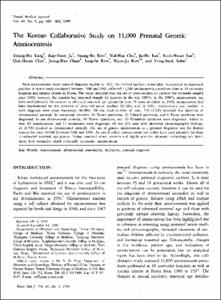KUMEL Repository
1. Journal Papers (연구논문)
1. School of Medicine (의과대학)
Dept. of Obstetrics & Gynecology (산부인과학)
The Korean collaborative study on 11,000 prenatal genetic amniocentesis
- Keimyung Author(s)
- Kim, Jong In
- Department
- Dept. of Obstetrics & Gynecology (산부인과학)
- Journal Title
- Yonsei Medical Journal
- Issued Date
- 1999
- Volume
- 40
- Issue
- 5
- Abstract
- Since amniocentesis made prenatal diagnosis feasible in 1967, the method has been remarkably instrumental in obstetrical practice. A recent study conducted between 1980 and 1997 collected 11,000 amniocentesis procedures done at 10 university hospitals and tertiary centers in Korea. The study indicated that the use of amniocentesis on patients has increased steadily since 1980; however, the number has increased sharply for patients in the mid 1990's. In the 1980's, amniocentesis had been used primarily for patients in advanced maternal age groups (at least 35 years or older). In 1995, amniocentesis had been implemented for the detection of abnormal serum markers (37.6%), and by 1997, amniocentesis was involved in such diagnosis even more frequently (44.8%). Of the total number of uses, 270 (2.5%) involved the detection of chromosomal anomaly. In autosomal disorders, 96 Down syndrome, 33 Edward syndrome, and 6 Patau syndrome were diagnosed. In sex chromosomal anomaly, 10 Turner syndrome, and 10 Klinefelter syndrome were diagnosed. Added to that, 83 translocations, and 15 mosaicisms were diagnosed. Of the 322 cases with abnormal ultrasonographic findings, 21 (6.5%) resulted in chromosomal anomaly. The use of genetic amniocentesis as a prenatal diagnostic test for Korean women has risen 10-fold between 1988 and 1998. As stated earlier, amniocentesis had earlier been used primarily for those in advanced maternal age groups. Today, maternal serum markers and highly sensitive ultrasonic technology can detect many fetal anomalies which eventually necessitate amniocentesis.
- Keimyung Author(s)(Kor)
- 김종인
- Publisher
- School of Medicine
- Citation
- Young Ho Yang et al. (1999). The Korean collaborative study on 11,000 prenatal genetic amniocentesis. Yonsei Medical Journal, 40(5), 460–466. doi: 10.3349/ymj.1999.40.5.460
- Type
- Article
- ISSN
- 0513-5796
- Appears in Collections:
- 1. School of Medicine (의과대학) > Dept. of Obstetrics & Gynecology (산부인과학)
- 파일 목록
-
-
Download
 oak-bbb-00036.pdf
기타 데이터 / 897.45 kB / Adobe PDF
oak-bbb-00036.pdf
기타 데이터 / 897.45 kB / Adobe PDF
-
Items in Repository are protected by copyright, with all rights reserved, unless otherwise indicated.